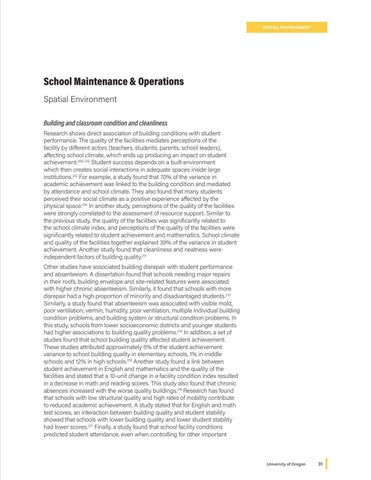SPATIAL ENVIRONMENT
School Maintenance & Operations Spatial Environment Building and classroom condition and cleanliness Research shows direct association of building conditions with student performance. The quality of the facilities mediates perceptions of the facility by different actors (teachers, students, parents, school leaders), affecting school climate, which ends up producing an impact on student achievement.209–212 Student success depends on a built environment which then creates social interactions in adequate spaces inside large institutions.212 For example, a study found that 70% of the variance in academic achievement was linked to the building condition and mediated by attendance and school climate. They also found that many students perceived their social climate as a positive experience affected by the physical space.210 In another study, perceptions of the quality of the facilities were strongly correlated to the assessment of resource support. Similar to the previous study, the quality of the facilities was significantly related to the school climate index, and perceptions of the quality of the facilities were significantly related to student achievement and mathematics. School climate and quality of the facilities together explained 39% of the variance in student achievement. Another study found that cleanliness and neatness were independent factors of building quality.211 Other studies have associated building disrepair with student performance and absenteeism. A dissertation found that schools needing major repairs in their roofs, building envelope and site-related features were associated with higher chronic absenteeism. Similarly, it found that schools with more disrepair had a high proportion of minority and disadvantaged students.213 Similarly, a study found that absenteeism was associated with visible mold, poor ventilation, vermin, humidity, poor ventilation, multiple individual building condition problems, and building system or structural condition problems. In this study, schools from lower socioeconomic districts and younger students had higher associations to building quality problems.214 In addition, a set of studies found that school building quality affected student achievement. These studies attributed approximately 5% of the student achievement variance to school building quality in elementary schools, 1% in middle schools and 12% in high schools.215 Another study found a link between student achievement in English and mathematics and the quality of the facilities and stated that a 10-unit change in a facility condition index resulted in a decrease in math and reading scores. This study also found that chronic absences increased with the worse quality buildings.216 Research has found that schools with low structural quality and high rates of mobility contribute to reduced academic achievement. A study stated that for English and math test scores, an interaction between building quality and student stability showed that schools with lower building quality and lower student stability had lower scores.217 Finally, a study found that school facility conditions predicted student attendance, even when controlling for other important
University of Oregon
31
